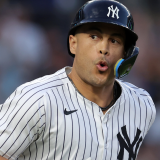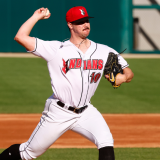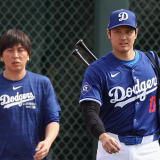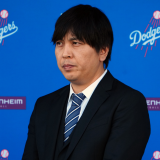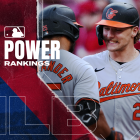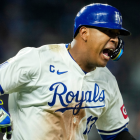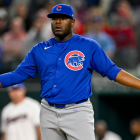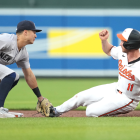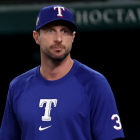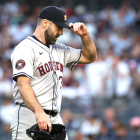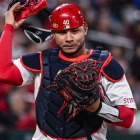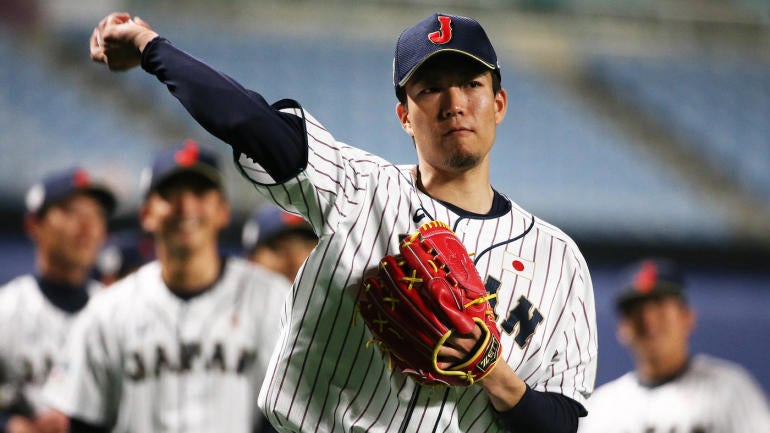
Nippon Professional Baseball, the world's second most prominent league, launched its season on June 19, three months after its original Opening Day plans were delayed due to the spread of the novel coronavirus.
NPB is the third league to get underway this year, joining Chinese Professional Baseball League (Taiwan) and Korea Baseball Organization (KBO).
Because American fans have more incentive than usual to get into NPB, we wanted to highlight 10 players worth knowing who have not played in Major League Baseball.
🇯🇵 🇯🇵 🇯🇵 HOOOOOOOOOOOOOOOOOOOOOOOOOOOOOOOOOOOME RUN Seiya SUZUKI #Premier12 @SamuraiJapan_pr #侍ジャパン pic.twitter.com/IPAXzpbCPc
— WBSC ⚾ #Premier12 (@Premier12) November 6, 2019
1. Seiya Suzuki (鈴木 誠也), OF, Hiroshima Toyo Carp
Suzuki was the most productive position player in NPB last season, according to DeltaGraphs' Wins Above Replacement measure. He hit .335/.453/.565 with 28 home runs and more walks than strikeouts. Factor in his above-average defense in right field, and it's easy to understand why he was estimated to have contributed nearly nine wins on the year.
Suzuki, 25, has a well-rounded game. He has one of the most discerning eyes in the league, and he's topped 25 home runs in each of the past four seasons. Defensively, he has a strong arm that serves as a reminder that he pitched as a youngster. He's tallied 24 assists since 2017; for comparison's sake, Bryce Harper led big-league right fielders in that category last season, and he has 22 assists over the same timeframe.
The one blemish for Suzuki is his basestealing. He's been a voluminous thief, averaging more than 15 stolen bases over the past four seasons, but not an efficient one. He's succeeded on just 63 percent of his 99 attempts during that stretch.
2. Tomoya Mori (森 友哉), C, Saitama Seibu Lions
The Pacific League's reigning Most Valuable Player, Mori earned the hardware by hitting .329/.413/.547 with 23 home runs and catching for the best team in the league.
Mori, who turns 25 in August, is a smaller backstop than what Americans are accustomed to seeing behind the dish. He's officially listed at 170 centimeters and 85 kilograms, or roughly 5-foot-6 and 187 pounds. MLB hasn't had a catcher that short who qualified for the batting title in any season since Yogi Berra last did it in the 1950s.
That tidbit isn't meant to discount Mori or his accomplishments, by the way, since he can clearly handle business. It just illuminates some of the subtle differences between leagues.
3. Hayato Sakamoto (坂本 勇人), SS, Yomiuri Giants
Whereas Mori won the Pacific League's MVP Award, Sakamoto took him the honors in the Central League. He did so by hitting .312/.396/.575 with 40 home runs.
Sakamoto is the oldest position player on this list, having turned 31 in December. It feels like he's been around much longer, given that he first became a regular with the Giants in 2008, when he was 19. He's since played in nearly every international event one can, including both the 2013 and 2017 World Baseball Classics, and it stands to reason those tournaments are as close as he'll come to suiting up against MLB talent regularly.
Even so, Sakamoto has already had a heck of a career. He's batted .292/.359/.457 with 1,886 hits, 223 home runs, and 152 stolen bases. He's made 11 All-Star Games and has won the Japan Series twice. And so on. Unfortunately, American fans might recognize Sakamoto's name only for a different reason: he recently tested positive for COVID-19.
Remembering 🇯🇵 Tetsuto Yamada's game-changing home run in the #Premier12 Final against 🇰🇷 Korea:
— WBSC ⚾ #Premier12 (@Premier12) March 23, 2020
Story: 📰 https://t.co/jszQ4hsUvg @samuraijapan_pr @swallowspr @PacificleagueTV pic.twitter.com/ZWZBTKIZVp
4. Tetsuto Yamada (山田 哲人), 2B, Tokyo Yakult Swallows
Sakamoto is unlikely to jump to the majors, but Yamada just might. He turned down a multi-year deal last winter, ostensibly with an eye on asking the Swallows to post him for big-league consideration after the season. If so, you can be certain he'll have suitors.
Yamada has been referred to as the "Mike Trout of Japan" for good reason. He's put together some jaw-dropping statlines over the years, including last season, when he hit .271/.401/.560 with 35 home runs and 33 steals (on 36 attempts). That performance gave him four 30-30 seasons in his last five tries, and left him with a career line of 297/.401/.526.
The Trout comparison works on another, unintended level. Yamada has less hardware than you'd expect: he won the Central League MVP Award in 2015, and that's about it.
9HR and 28RBI in just 20 games. New slugger of NPB, Hotaka Yamakawa. #npbeng #HotakaYamakawa pic.twitter.com/R2hNyk6bd1
— パ・リーグ.com / パーソル パ・リーグTV公式 (@PacificleagueTV) April 25, 2018
5. Hotaka Yamakawa (山川 穂高), 1B, Saitama Seibu Lions
It's easy to get caught up in what Yamakawa doesn't provide. He's a 28-year-old, 5-foot-9 right-handed first baseman with a well-below-average glove and set of wheels. He's also prone to swinging and missing, resulting in one of the highest strikeout rates in the league; and so on. If he were in the majors, he'd be a rough season away from being non-tendered.
We're including Yamakawa because he does one thing exceptionally well: slug. His career ISO is .294, or 10 points from Joey Gallo's (.304). In addition, he's homered 90 times over the last two seasons, including 43 in 2019, which tied Neftali Soto for the most in the league. Secondary value matters, but sometimes it's just fun to watch someone hit dingers. Yamakawa is good for the latter, even if that's all he's good for on a baseball diamond.
8IP, 95p, 2H, 7K, 0BB, and 0ER・R. Kodai Senga dominated the game. #npbeng pic.twitter.com/JzLy9vTXEf
— パ・リーグ.com / パーソル パ・リーグTV公式 (@PacificleagueTV) July 29, 2017
6. Kodai Senga (千賀 滉大), RHP, Fukuoka SoftBank Hawks
It's fair to call Senga NPB's premier pitcher due to his performance and talent levels. In 2019, he led qualifiers in innings, strikeout rate, and fastball velocity (95 mph) while posting the league's fifth best ERA. It's fair, then, to describe him as NPB's premier pitcher. He also led the league in walk percentage, so it isn't all butterflies and cupcakes here.
The main question with Senga, 27, is how much longer he'll remain in Japan. He asked the Hawks to post him for big-league consideration over the winter, but the team rejected that request. Should the Hawks hold firm, he might have to wait until 2022 to come over.
Whenever Senga arrives, he has the potential to be at least a mid-rotation starter. In addition to his mid-90s fastball, he has a cutter, a slider, and an elite forkball/splitter that serves as his top outpitch. If he can improve his command, then he could be given a different title someday down the road: big-league ace.
7. Shota Imanaga (今永 昇太), LHP, Yokohama DeNA BayStars
8. Yasuaki Yamasaki (山崎 康晃), RHP, Yokohama DeNA BayStars
We'll save space by combining the write-ups for a pair of BayStars.
Imanaga is a short, physical 26-year-old who rebounded from a rough 2018 in a big way last season. He threw a career-high 170 innings while posting a 2.91 ERA and 3.32 strikeout-to-walk ratio, fueled in large part by the league's highest non-Senga strikeout rate.
To be clear: Imanaga doesn't possess Senga's top-shelf stuff. His fastball sits in the low-90s (good for the fourth-highest average velocity among qualified starters), and he complements it with a full slate of secondary offerings.
Yamasaki is a 27-year-old reliever with a career 2.34 ERA and 163 saves. His fastball sits in the mid-90s and he throws a splitter. More importantly: he knows how to enter in style:
This is why Japanese baseball is amazing: Yakult Swallows closer Yasuaki Yamazaki comes in from the bullpen on a sports car. pic.twitter.com/Cm19SHZxDa
— joon lee (@joonlee) June 26, 2017
9. Kohei Arihara (有原 航平), RHP, Hokkaido Nippon-Ham Fighters
Arihara, 27, has a lot working in his favor as it pertains to coming stateside (something he reportedly has interest in doing). For one, he's a former teammate of Shohei Ohtani who has been on teams' radars for years as a result. For another, his build is the most prototypical of the pitchers included in this piece, at 6-foot-2 and 211 pounds.
Arihara is more than a name and a frame. He's coming off a fantastic season that saw him post a 2.46 ERA and 4.03 strikeout-to-walk ratio across 164 innings. His fastball sits in the low-90s and he has a full cupboard of secondary offerings, including a splitter and changeup that he throws a combined 30 percent of the time, per DeltaGraphs.
Don't be surprised if Arihara ends up serving as some big-league team's No. 3 or 4 starter in a few years' time. For now, he'll continue to serve as the Fighters' ace.
One of hopeful prospect player in NPB, Yoshinobu Yamamoto.https://t.co/UNBh3Va9rT #npbeng #YoshinobuYamamoto pic.twitter.com/QJO9j5svDY
— パ・リーグ.com / パーソル パ・リーグTV公式 (@PacificleagueTV) May 2, 2018
10. Yoshinobu Yamamoto (山本 由伸), RHP, Orix Buffaloes
We'll end with Yamamoto, who seems primed to succeed Senga as the league's gold standard.
Yamamoto is only 21 years old, but he's already proven to be a force. He led the league in ERA last season, accumulating a 1.95 figure over 149 innings. His fastball clocked in as the second-hottest among qualifiers, averaging around the mid-90s, and he complemented it with a deep arsenal, including, among other pitches, a promising splitter and cutter/slider.
There are knits to pick with Yamamoto -- he's on the shorter side and he has a busy delivery -- but should he continue to progress as expected, he'll be someone who American fans will become familiar with in due time.







